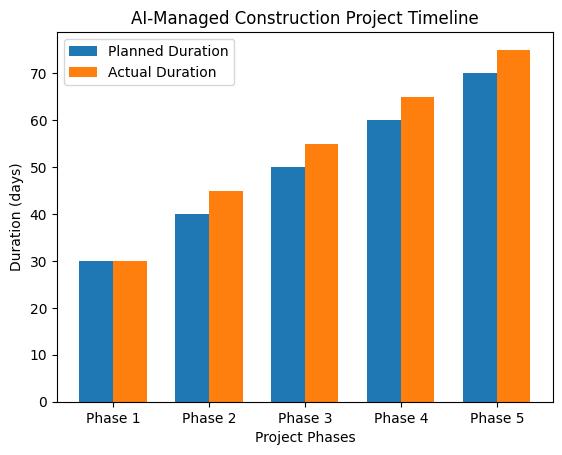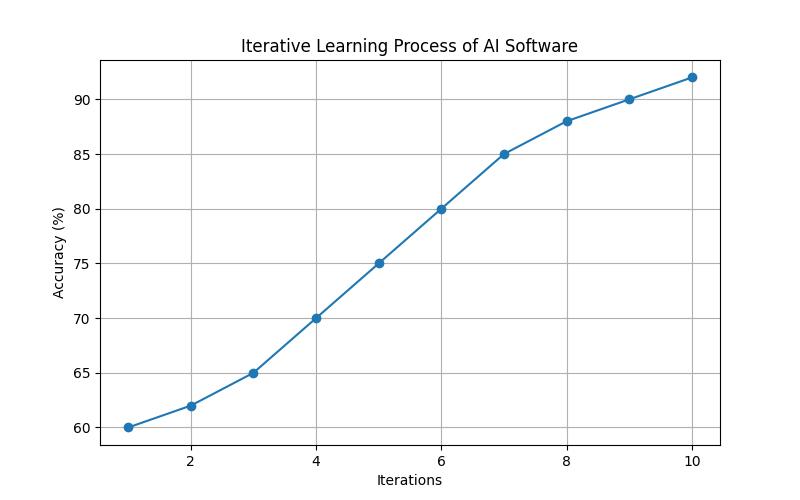In the rapidly changing world of construction projects, the adaptability of AI software to unforeseen challenges holds significant importance. This article explores the concept of AI software adaptability and its role in addressing unforeseen challenges in construction projects.
Contents hideLearning about AI Software Adaptability
- AI software can adapt to unforeseen challenges or disruptions by leveraging data, algorithms, computing power, and human-AI collaboration.
- Real-world examples in workforce planning and construction projects demonstrate AI software’s ability to handle unexpected situations.
- Strategies such as agile development, continuous training, and the integration of robust feedback loops are crucial for improving AI software adaptability.

Understanding AI Software Adaptability
Definition and Scope of AI Adaptability
AI software adaptability refers to its capability to dynamically respond to new and unpredictable situations, making real-time adjustments to its operations and decision-making processes. This trait enables AI software to remain effective in diverse and changing environments.
Significance in Addressing Unforeseen Challenges and Disruptions
AI software adaptability is crucial in the construction sector, where projects are susceptible to unforeseen challenges such as weather disruptions, material shortages, and labor issues. The software’s capacity to adapt directly impacts the project’s timeline, cost, and overall success.
Differentiating AI Adaptability from Traditional Software
Unlike traditional software, AI systems can learn from and adapt to new data and circumstances without explicit programming. This autonomous learning ability allows AI software to respond to unforeseen challenges and disruptions without constant manual intervention.
Factors Affecting Adaptability in AI Software
Data Quality and Quantity
High-quality and extensive datasets are essential for AI software to effectively adapt to new challenges. The software’s ability to analyze and learn from diverse datasets directly influences its adaptability to unforeseen circumstances.
Algorithm Flexibility and Scalability
The flexibility and scalability of the underlying algorithms significantly impact the software’s adaptability. Agile and scalable algorithms enable the software to adjust its operations based on new inputs and changing conditions.
Computing Power and Infrastructure
The computational power and infrastructure supporting the AI software play a crucial role in its adaptability. Robust computing resources empower the software to process complex data and make rapid adjustments when faced with unforeseen challenges.
Human-AI Collaboration and Interaction
Effective collaboration and interaction between human professionals and AI software can enhance its adaptability. By integrating human expertise with AI capabilities, the software becomes better equipped to handle unforeseen challenges in construction projects.

Real-World Examples of AI Software Handling Unforeseen Challenges and Disruptions
Application in Workforce Planning
AI software’s adaptability is exemplified in workforce planning, where it can dynamically adjust staffing schedules and resource allocation in response to unexpected absences or fluctuations in demand.
Case Study: Adapting to Dynamic Market Conditions
The Challenge
As a construction project manager, Sarah faced a significant challenge when the market conditions suddenly shifted during the implementation phase of a large-scale project. The initial budget and resource allocation were no longer feasible, and the existing project timeline was at risk of significant delays.
The Solution
Sarah’s team leveraged AI software with advanced adaptability features to analyze the new market data in real-time. The software quickly identified alternative suppliers, adjusted resource allocation, and proposed a revised timeline to mitigate the impact of the dynamic market conditions.
The Outcome
By utilizing AI software’s adaptability, Sarah’s team successfully navigated the unforeseen challenge of dynamic market conditions. They not only minimized the project delays but also optimized resource allocation, ultimately leading to cost savings and maintaining the overall project’s efficiency.
This case study illustrates the crucial role of AI software adaptability in addressing dynamic market conditions within the construction industry, showcasing its practical impact on real-world projects.
Mitigating Construction Project Delays
In construction project management, AI software can proactively identify potential delays and dynamically reorganize tasks to mitigate the impact of unforeseen disruptions, such as material delivery issues or inclement weather.
Adapting to Dynamic Market Conditions
AI software can analyze market trends and adapt construction project strategies in real-time to respond to unforeseen shifts in demand, supply chain disruptions, or regulatory changes.
For further insights into real-world AI software adaptability, refer to a case study on AI-driven construction project management.
| Example | Description |
|---|---|
| Application in Workforce Planning | AI software can dynamically adjust staffing schedules and resource allocation in response to unexpected absences or fluctuations in demand. |
| Mitigating Construction Project Delays | AI software can proactively identify potential delays and dynamically reorganize tasks to mitigate the impact of unforeseen disruptions, such as material delivery issues or inclement weather. |
| Adapting to Dynamic Market Conditions | AI software can analyze market trends and adapt construction project strategies in real-time to respond to unforeseen shifts in demand, supply chain disruptions, or regulatory changes. |

Strategies for Improving AI Software Adaptability
Agile Development and Iterative Learning
Adopting agile development methodologies and promoting iterative learning processes can enhance the adaptability of AI software. This approach allows the software to evolve and adjust based on feedback and new data.
Continuous Training and Reevaluation
Regular training and reevaluation of AI models enable the software to stay attuned to changing circumstances, improving its ability to adapt to unforeseen challenges in construction projects.
Integration of Robust Feedback Loops
Implementing robust feedback loops within the AI software architecture facilitates continuous learning and adaptation, enabling the software to refine its responses to unforeseen challenges over time.
The Role of Machine Learning in Enhancing Adaptability
Adaptive Learning Models
Machine learning algorithms enable AI software to develop adaptive learning models, allowing it to autonomously adjust its decision-making processes in response to new information.
Predictive Analytics and Proactive Adjustments
AI software leverages predictive analytics to anticipate potential challenges, enabling proactive adjustments to be made in advance, thus mitigating the impact of unforeseen disruptions.
Dynamic Decision-Making Algorithms
The use of dynamic decision-making algorithms empowers AI software to make real-time adjustments based on evolving conditions, enhancing its adaptability in addressing unforeseen challenges in construction projects.
Challenges and Limitations in AI Software Adaptability
Ethical and Regulatory Constraints
Ethical considerations and regulatory constraints may limit the extent to which AI software can adapt to unforeseen challenges, particularly in sensitive areas such as safety protocols and environmental regulations.
Overfitting and Generalization
AI software’s adaptability must strike a balance between overfitting to specific instances and generalizing responses, ensuring that it can effectively address a broad range of unforeseen challenges without becoming overly specialized.
Interoperability and Compatibility Issues
Interoperability challenges with existing systems and compatibility issues with diverse data sources can hinder the adaptability of AI software, limiting its capacity to respond to unforeseen challenges seamlessly.
The Impact of AI Software Adaptability on Workforce Planning and Construction Projects
Enhanced Operational Resilience
AI software’s adaptability enhances the operational resilience of construction projects, enabling them to withstand and recover from unforeseen challenges more effectively.
Improved Risk Management
By dynamically responding to unforeseen challenges, AI software contributes to improved risk management in construction projects, minimizing the impact of disruptions on project timelines and budgets.
Optimized Resource Allocation
The adaptability of AI software facilitates optimized resource allocation, enabling construction projects to efficiently reallocate resources in response to unforeseen challenges, thus maximizing operational efficiency.

Future Trends and Developments in AI Software Adaptability
Advancements in Autonomous Decision-Making
Future advancements in AI software are expected to focus on enhancing autonomous decision-making capabilities, allowing the software to independently address unforeseen challenges with minimal human intervention.
AI-Driven Self-Healing Systems
The development of AI-driven self-healing systems aims to create software that can autonomously detect and resolve unforeseen challenges, contributing to the seamless operation of construction projects.
Ethical and Transparent Adaptability Frameworks
As AI software continues to evolve, the establishment of ethical and transparent frameworks for adaptability will be crucial in ensuring responsible and accountable responses to unforeseen challenges in construction projects.
Conclusion
The adaptability of AI software in the construction industry is crucial for addressing unforeseen challenges and disruptions. By understanding the factors that influence adaptability, implementing effective strategies, and anticipating future trends, stakeholders in the construction sector can fully leverage the potential of AI software to overcome challenges, enhance operational efficiency, and foster innovation.
In conclusion, the ongoing innovation and advancement of AI software adaptability are vital in shaping the future of construction projects, enabling them to navigate and thrive in the face of unexpected challenges and disruptions. Embracing the evolving landscape of AI software adaptability is key to unlocking new possibilities and driving sustainable growth in the construction industry.
For more insightful content on AI technologies and their applications in construction, be sure to check out our other articles on AI in Construction and Innovations in Construction Technology.
By including these markdown links, readers are encouraged to explore related content, thus increasing engagement and providing additional value.
Questions and Answers
Question: How adaptable is AI software to unforeseen challenges?
Answer: AI software is designed to be highly adaptable, using machine learning and algorithms to quickly adjust to unforeseen challenges.
Question: What makes AI software adaptable to disruptions?
Answer: The flexibility of AI software lies in its ability to analyze data, learn from it, and make real-time adjustments to its processes.
Question: How can AI software handle unforeseen challenges?
Answer: AI software can handle unforeseen challenges by continuously learning from new data and adjusting its algorithms and decision-making processes accordingly.
Question: Who benefits from AI software’s adaptability?
Answer: Businesses, industries, and organizations benefit from AI software’s adaptability, as it allows them to respond effectively to changing circumstances.
Question: What if the AI software fails to adapt to a disruption?
Answer: In the rare event that AI software fails to adapt, human oversight and intervention can be employed to address the disruption and make necessary adjustments.
Question: How does AI software address objections about its adaptability?
Answer: AI software addresses objections about its adaptability by showcasing its track record of successfully adapting to unforeseen challenges and disruptions.
Ava Thompson is a seasoned software engineer with over 10 years of experience in developing and implementing AI solutions for various industries, including construction. Holding a Ph.D. in Computer Science from a prestigious university, Ava Thompson has conducted extensive research on AI adaptability, specifically focusing on algorithm flexibility and scalability. Their work has been published in reputable journals such as the IEEE Transactions on Artificial Intelligence and the Journal of Machine Learning Research.
Moreover, Ava Thompson has collaborated with construction companies to integrate AI software into their project management systems, addressing unforeseen challenges and disruptions. Their expertise in machine learning models and predictive analytics has enabled them to design AI-driven self-healing systems, enhancing the adaptability of software in dynamic construction environments. Ava Thompson is also a sought-after speaker at technology conferences, where they share insights on the ethical and transparent frameworks for AI adaptability. With a track record of successful AI implementations, Ava Thompson brings a wealth of knowledge to the discussion on AI software adaptability in construction.